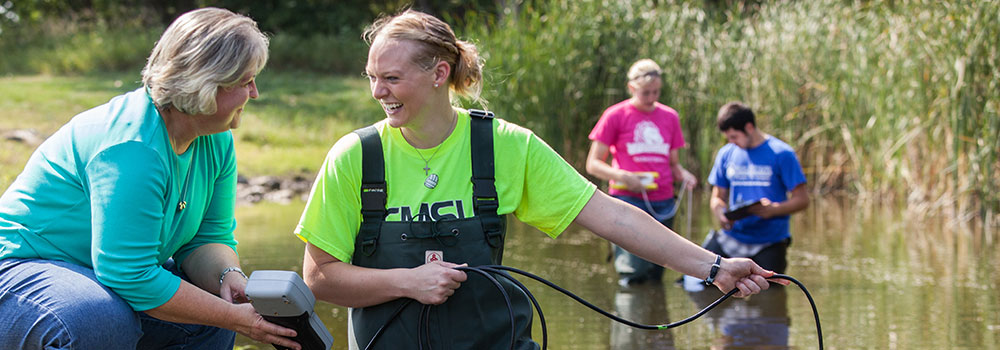Environmental Science Program

About the Program
The Environmental Science Program provides students with an in-depth understanding of natural systems and how human;interact with the environment. It prepares students for careers and graduate studies in environmental science and provides the academic basis to analyze environmental problems from several perspectives. The Environmental Science major offers students the flexibility of choosing from two emphasis areas: Natural Science or Humanity and Environment. Each option prepares students for a particular career track.
To meet these goals, the Environmental Science Program offers a diversified selection of courses in the biological, chemical, and physical sciences. Supporting courses in biology, chemistry and geology are an important part of this curriculum in that they provide additional skills and knowledge required of environmental scientists.
See the Program Goals and Student Learning Outcomes for Environmental Science.
Majors & Minors
Clubs Related to the Major
Career Opportunities
Graduates with a Bachelor of Science degree in environmental science may choose from a number of growing career possibilities.
The Natural Science option, with its strong physical and life science components, prepares students for graduate studies or employment in areas such as environmental education centers, or government agencies such as the Department of Natural Resources or the Environmental Protection Agency.
The Humanity and Environment option is designed for liberal arts students with an interest in communicating information about the environment. The academic preparation provided by this option is useful for students interested in careers in environmental law, environmental journalism, environmental education, and local, state or federal government.
Undergraduate Research
All Environmental Science students conduct a research project as part of their Senior Capstone requirement and present their results at the SMSU Undergraduate Research Conference the fall of their senior year. A Research Methods course taken junior year guides Environmental Majors through the development of a project idea, preparation of an extensive literature review, and writing of a research proposal, followed by the Capstone course in which students analyze their data and complete their projects and prepare for their presentation.
The purpose of the SMSU Undergraduate Research Conference is to highlight the work done by all undergraduate students at SMSU. It is an annual, one-day conference at which hundreds of SMSU students engage in a professional exchange of ideas and showcase their hard work and accomplishments to the community and potential future employers.
Facilities & Resources
The program is housed in the Science & Math and Science & Technology buildings and include newly renovated laboratories which give the Environmental Science program state-of-the-art facilities in which to teach and conduct research. The labs contain solutions preparation areas, a variety of instruments for cellular and molecular studies, and controlled environmental chambers. SMSU also has a Greenhouse, a Museum of Natural History and a Planetarium. A well-equipped soils lab allows for physical and chemical characterization of soil and sediment samples. The department also has extensive teaching and research collections of plants, rocks, minerals, fossils and preserved specimens in addition to a rock and fossil preparation area. A 40-acre Wildlife Area is located on campus and features a variety of plant communities including prairie, wetlands, and coniferous and deciduous forests. The Wildlife Area is used extensively in field-based courses and research projects. Civic engagement opportunities are available through the Redwood River Mentoring and Monitoring Project a joint effort with local public schools. Additional opportunities include internships and projects with a variety of local government agencies. SMSU’s Geographic Information Center (GIS Center) contains state-of-the art computer analysis and mapping equipment. Having GIS knowledge is a skill increasingly desired by many employers. All Environmental Science students are required to take a GIS course as part of their major.
Contact Information
Science Department, Environmental Science
SM 178, Southwest Minnesota State University
1501 State St.
Marshall, MN 56258
- Telephone: (507) 537-6178
- Fax: (507) 537-6151
“I always tell people about how impressed I am with the program. It is very well thought out and the professors are truly passionate and give the students the best preparation for the future.”
FRESHMAN ADMISSION PROCESS
- Complete Application
- $20 Non-refundable Application Fee
- Official High School Transcript(s)
- ACT or SAT Test Scores
FRESHMAN ADMISSION REQUIREMENTS
- Rank in the upper half of graduating class
- or
- Score a composite of 21 or above on the ACT or 990 on the SAT
Last Modified: 11/27/23 8:47 AM | Website Feedback



